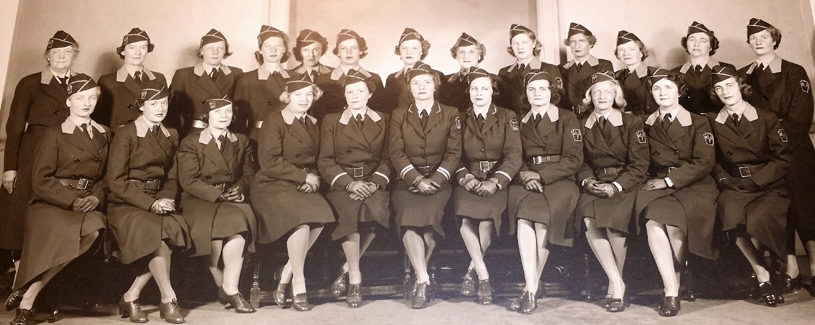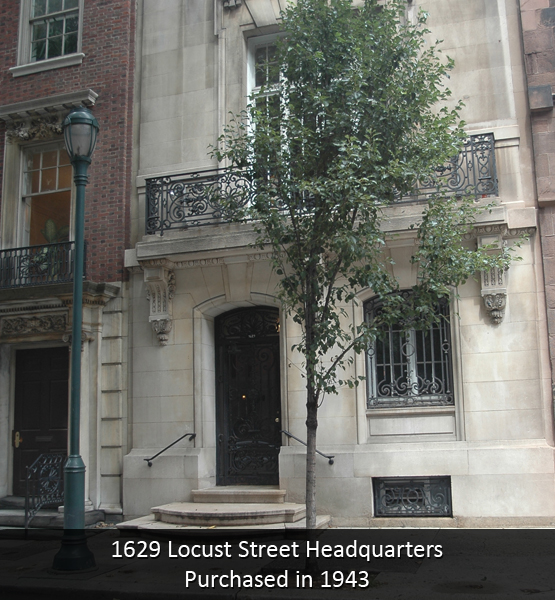

Elizabeth Price Martin (Mrs. J. Willis Martin)

Ella McFadden Browning (Mrs. Edward Browning)

Mary Wanamaker Warburton (Mrs. Barclay Warburton)

Agnes Roberts Groome (Mrs. John Groome)

Elizabeth Wanamaker McLeod (Mrs. Norman McLeod)

Esther Harrison Rowland (Mrs. Edward K. Rowland)

Marian Hall Horwitz (Mrs. George Q. Horwitz)

Anita Porter Clothier (Mrs. William J. Clothier)

The Emergency Aid of Pennsylvania Foundation (EA) has a century-long history rich in service to the Philadelphia region. It was established in 1914 by eight Philadelphia women at a time when the country was facing a depressed economy, high unemployment and a war erupting in Europe. Their efforts were initially directed at aiding foreign relief during World War I, combatting the influenza and Infantile Paralysis (polio) epidemics, and alleviating the effects of unemployment which was so harshly impacting the city of Philadelphia.
They raised money, collected clothes and supplies that were desperately needed, and shipped them overseas to Belgium, the first country that asked for help from the U.S.. As the war progressed, the women set up relief committees for each specific country as it joined the Allied forces.
The Emergency Aid volunteers worked in hospitals, collected food and clothing for the unemployed, and set up a food distribution center to provide wheat flour, cereal, canned goods, fresh vegetables and bread. Welfare agencies, hospitals, and day nurseries city-wide relied on the center for supplies. Many committees were formed to meet the burgeoning needs, among them: Food Distribution, Motor Messengers, Soldiers’ and Sailors’ Club, and the American Ambulance Hospital. EA continued vigorously through the 1920s and then the Depression era, delivering help wherever there was a need.
Some of the EA volunteers wore uniforms, had military ranks, and participated in drills at the Broad Street Armory. Because of their duties in hospitals and the requirements of their other undertakings, it was necessary to adopt a uniform to be recognized as the EA.
In 1926, The Emergency Aid was one of the women’s organizations that mounted the High Street Exhibit at the Sesquicentennial Celebration. The Indian Queen Inn, designed after the old inn on High Street in Philadelphia (now Market Street), was sponsored by EA. The inn provided a place where visitors could stop for refreshments. There is now an Indian Queen Room represented at the Strawberry Mansion in Fairmount Park that contains some of the original antiques from the early inn.
The United Christmas Bazaar, one of the most important and well known projects of the Emergency Aid of PA, was launched in 1927. The bazaar incorporated a number of holiday fairs into one. EA sponsored and underwrote the expense of the Bazaar, so that all the participating organizations retained their profits. The annual Bazaar benefited children, the aged, the disabled, hospitals and charity homes for many decades to come.
During World War II, our organization secured and sent relief supplies to the Allies, and provided housing information for officers and enlisted men and women. Among its very diverse wartime initiatives The Emergency Aid sold over $68 million in war bonds, and with the proceeds of those bond sales they were able to buy two general hospitals – one overseas and one in the United States, two Thunderbolt planes, and a hospital ship costing $3 million.
Over time The Emergency Aid became the largest volunteer women’s organization in the Philadelphia region, continuing to raise funds for programs in the area, and researching projects they felt needed their attention and help. By the early 1980s, programs pioneered by EA had been incorporated into professional organizations throughout the Philadelphia area.
In 1984, the Foundation was formed by members who were determined to infuse the spirit and tradition of its past with a keen awareness of ever-changing conditions and with the flexibility to respond to those new needs.
Today, in our second century, EA’s mission is accomplished by our two vital initiatives:
- The Emergency Aid awards Grants to local non-profit organizations that work to improve the lives of women, children and families. Nearly $2,000,000 has been given out in grants, with $50,000 to $60,000 in grant funding awarded each year.
- The Emergency Aid promotes the education and careers of young women through our Founders Award Program and our Scholarships. We mentor them through high school and provide community service projects and seminars in order to develop in them self-confidence and leadership skills. There are currently 60 young women from high schools in the Philadelphia region participating in our Founders Award Program.

In addition, EA provides financial aid to many of our Founders Award graduates through our Scholarship Program. Approximately 30 scholarship recipients are attending colleges throughout the country at any one time. In recent years EA has awarded over $500,000 in scholarships.
The Emergency Aid of Pennsylvania has been an integral part of Philadelphia’s history for over 100 years. The young women we have mentored are making their own mark on history through their leadership roles in education, the business world and service to our country. And the families who are served by our grants are ever grateful to have their challenges addressed and their futures brightened.
Today, and for more than a century, the dedicated women of The Emergency Aid continue to give exceedingly generously of their time, their talent and their financial resources to accomplish our mission of making a significant difference in the lives of women and children throughout the Philadelphia area.
To read more about EA you can find our records and archives at The Pennsylvania Historical Society and our uniforms and artifacts at the Philadelphia History Museum at The Atwater Kent Museum.
- The Emergency Aid was founded by eight Philadelphia women in October 1914 to provide relief to those suffering abroad from the hardships of World War I.
- Its reputation spread such that within six months former President Theodore Roosevelt visited its Home Relief headquarters, which had been donated, with utilities, by Rodman Wanamaker.
- In response to a request from Washington D.C. it collected funds and clothing for Belgian relief so effectively that it supported 11 towns and 2,000 Belgian children with food, as well as raising thousands of dollars for The American Hospital in Paris and shipping tons of coal there.
- The Governor of Pennsylvania designated The Emergency Aid to be the primary agency to send supplies and comforts to the Pennsylvania men overseas. The American Soldiers and Sailors Club was opened in Paris to serve as an intake location for those supplies.
- The Mayor of Philadelphia appointed The Emergency Aid to partner with the Red Cross to provide civilian relief at home for the families of enlisted men.
- The Emergency Aid raised millions of dollars for the civilian needy during the war, and reclaimed and repaired 35,000 overcoats for servicemen.
- The Emergency Aid sent six Philadelphia women to the war zone to work as volunteers, and it supervised the recruiting of 5,000 women for war service at eight recruiting stations.
- The Emergency Aid managed the canteen for the workers at the Frankfort Arsenal.
- In Europe, The Emergency Aid founded a permanent hospital for sick children, supported a convalescence home in Belgium, and assisted Washington to feed 3,500,000 starving children.
- At home, The Emergency Aid established The Girls’ Trade School in Philadelphia for women factory workers who were out of work.
